Wednesday, 28 May 2014: Perpignan, the palace and the guided tour
Written 2 June
I got up promptly and logged on to the website of db Bistro Moderne at what must have been about 1:00 a.m. in New York only to find that the 7:30 p.m. dinner slot I hoped for was already gone. Had to settle for 7:45 p.m. Good thing we're an hour east of Greenwich; if I'd tried at breakfast EDT, we would probably have been shut out altogether.
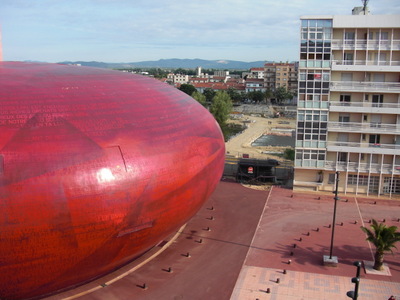
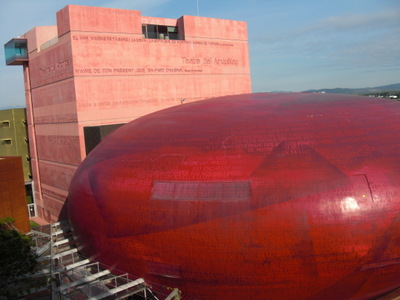 At the left is the view from my fifth-floor hotel room and at the right, a better shot (which I got by sticking my camera arm way out the window) of the bizarre red object that dominates the view. When I first looked out, though, it was only the second thing I noticed. What first caught my eye was that incredibly ugly little causeway across the Têt River, between the red object and the apartment building to its right (note the little red "for sale" sign in one of the apartment windows). After studying it a while, I came to the conclusion that it must be temporary. It seems to connect the two sides of a construction site than spans the stream. To facilitate construction traffic back and forth, they laid a whole row of large culvert pipes side by side, then just poured a thick layer of gravel over the top, forcing the river to flow through the pipes to get past. With luck, it will be gone in a few weeks or months.
At the left is the view from my fifth-floor hotel room and at the right, a better shot (which I got by sticking my camera arm way out the window) of the bizarre red object that dominates the view. When I first looked out, though, it was only the second thing I noticed. What first caught my eye was that incredibly ugly little causeway across the Têt River, between the red object and the apartment building to its right (note the little red "for sale" sign in one of the apartment windows). After studying it a while, I came to the conclusion that it must be temporary. It seems to connect the two sides of a construction site than spans the stream. To facilitate construction traffic back and forth, they laid a whole row of large culvert pipes side by side, then just poured a thick layer of gravel over the top, forcing the river to flow through the pipes to get past. With luck, it will be gone in a few weeks or months.
The big red thing, though, is a permanent fixture, the Theater of the Archipelago, which fills one end of the oval Espace Med. As far as we can tell, the red glob is the auditorium, and the tall rectilinear part is the scene loft. It's labeled near the top in Catalan and on a different side in French. It's covered with painted fragments of quotations and poetry (hard to read because they overlap each other extensively) on the theme "grenat," which I initially took to mean "pomegranate"; after all, what else would you call a building that shape and color? But then I learned I'd mistaken the word; pomegranate is "grenade" (yes, just like the hand-thrown explosive device); "grenat" means "garnet, and we soon learned that this region is famous for the mining and working of garnets. We deduce that Perpignan calls itself the Archipelago, though I'm not sure why.
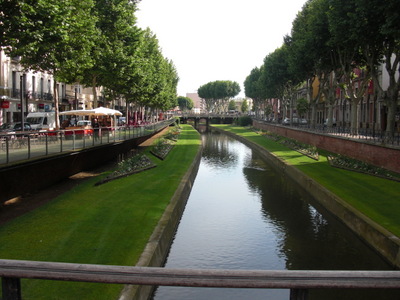
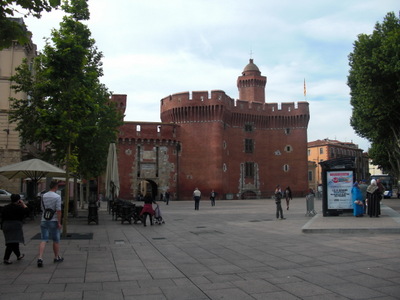 First order of business was to stop by the Office de Tourisme, and we were pleased to see on the city map the hotel gave us that a branch of it was located quite close by, on the banks of the Basse, Perpignan's other, smaller river, shown here at the left. As you can see, it's a very manicured, well-behaved little river; this stretch is rather bare, but most of it is lined with flowering shrubs in addition to the grass, as well as larger flower beds that appear here. We found no evidence of stairs down, so apparently you're supposed to look but not walk.
First order of business was to stop by the Office de Tourisme, and we were pleased to see on the city map the hotel gave us that a branch of it was located quite close by, on the banks of the Basse, Perpignan's other, smaller river, shown here at the left. As you can see, it's a very manicured, well-behaved little river; this stretch is rather bare, but most of it is lined with flowering shrubs in addition to the grass, as well as larger flower beds that appear here. We found no evidence of stairs down, so apparently you're supposed to look but not walk.
The branch tourism office turned out to be closed for the season; please go to the main office in the Palais des Congrés (the one we already knew about, in the convention center (where the 1993 Meiofauna Congress was held). So we strolled along the Basse in that direction, encountering on the way the Castillet (show at the right), once the principal gate to the city and left standing when the rest of the walls were torn down. As you can see, it is (and the walls it was once part of were) red brick, a common building material in the region. It has become the symbol of the city.
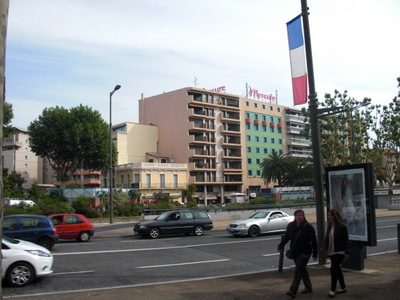
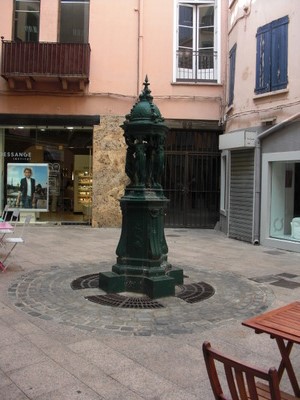 Next, we passed the Mercure hotel where we stayed in 1993. That was our first encounter with an Accor hotel, and it made a very favorable impression despite its gaudy pink and green decor and the gigantic neon "Mercure" on top—I'm not sure whether I think it's cool or horrifying that that neon monstrosity is still there!
Next, we passed the Mercure hotel where we stayed in 1993. That was our first encounter with an Accor hotel, and it made a very favorable impression despite its gaudy pink and green decor and the gigantic neon "Mercure" on top—I'm not sure whether I think it's cool or horrifying that that neon monstrosity is still there!
We finally reached the Office de Tourisme; stocked up on all maps, brochures, and other info we needed; and signed up for the 2:30 p.m. walking tour of the oldest section of the city. Presumably, if we'd been in town long enough, we could have signed up for tours covering the other three of its four major areas. Next on the agenda was a tour of the palace of the kings of Majorca, who used to live here and reigned over Perpignan as well. On the walk up there, we passed this Wallace fountain—they turn up in the most amazing places! I don't know whether Mr. Wallace actually presented some to cities other than Paris or whether, as they get displaced from their original spots in Paris (e.g., by new construction), the get bought up and moved elsewhere.
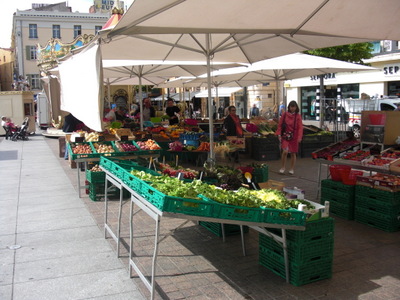
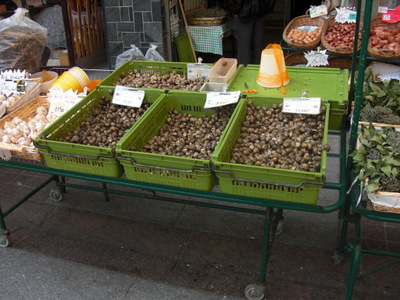 We also passed through a small market in progress in the Place de la République. At the left, an array of fruits and vegetables. At the right, three sizes of live snails for sale. They're all "petits gris" (Helix aspersa, little grays, as opposed to the larger, rounder snails of Burgundy), but they're priced, from smallest to largest, at 8, 10, 12 euros (per hundred, I think).
We also passed through a small market in progress in the Place de la République. At the left, an array of fruits and vegetables. At the right, three sizes of live snails for sale. They're all "petits gris" (Helix aspersa, little grays, as opposed to the larger, rounder snails of Burgundy), but they're priced, from smallest to largest, at 8, 10, 12 euros (per hundred, I think).
Below at the left are bins of fresh sardines (left) and anchovies (right). The sardines are cheaper. The next stall over (not shown) displayed heaps of dried salted fishes, whole little ones and chunks of larger ones, as well as all manner of canned fish and seafood products.
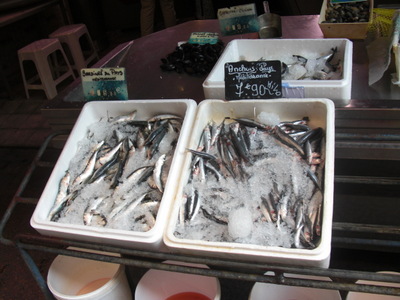
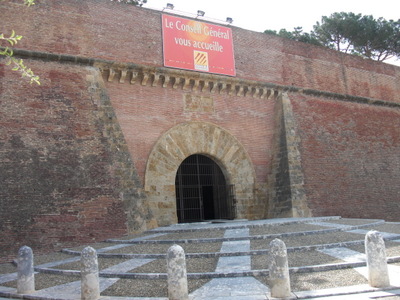 Anyway, when the kings of Majorca took over in 1276, and were in town, they had to stay with the bishop or rich locals, because the city didn't have a suitable palace. Building one took 35 years, and originally, it wasn't fortified; it just sat splendidly on top of its hill south of town. In 1349, the kings of Majorca were defeated by the kings of Aragon, and Aragon and France split up their territories. Later, during the Franco-Spanish wars of the mid 16th century, Perpignan was right on the disputed border, so the palace was enclosed in the massive star-shaped fortress whose entrance appear at the right. (Whenever you look at a map of a French city and see that characteristic star shape, you know what we'll soon be touring.) Later still, when Louis XIV was busy defending and trying to expand his borders, the fortifications were reinforced by (who else?) Vauban. The man was everywhere.
Anyway, when the kings of Majorca took over in 1276, and were in town, they had to stay with the bishop or rich locals, because the city didn't have a suitable palace. Building one took 35 years, and originally, it wasn't fortified; it just sat splendidly on top of its hill south of town. In 1349, the kings of Majorca were defeated by the kings of Aragon, and Aragon and France split up their territories. Later, during the Franco-Spanish wars of the mid 16th century, Perpignan was right on the disputed border, so the palace was enclosed in the massive star-shaped fortress whose entrance appear at the right. (Whenever you look at a map of a French city and see that characteristic star shape, you know what we'll soon be touring.) Later still, when Louis XIV was busy defending and trying to expand his borders, the fortifications were reinforced by (who else?) Vauban. The man was everywhere.
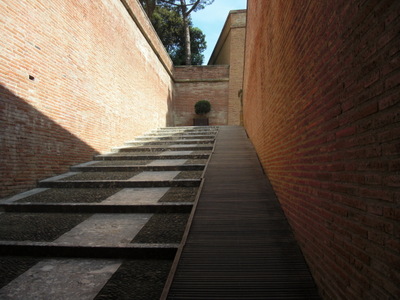
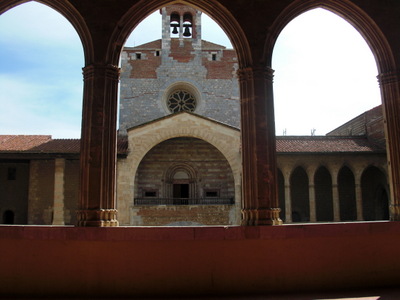 Inside the entry, we found this long flight of shallow stone steps, flanked by a much more comfortable wooden ramp. At the end of it, we found another, and at that end of that a third. After that, we had only to climb an ordinary flight of metal stairs to the reception desk. We got a discount on admission with the "city passes" that were thrown in when we bought our afternoon tour tickets.
Inside the entry, we found this long flight of shallow stone steps, flanked by a much more comfortable wooden ramp. At the end of it, we found another, and at that end of that a third. After that, we had only to climb an ordinary flight of metal stairs to the reception desk. We got a discount on admission with the "city passes" that were thrown in when we bought our afternoon tour tickets.
At the level of the ticket office (i.e., one flight up from the floor of the central courtyard), was a broad covered balcony called the "throne room." At the right is a photo out through its arches and across the courtyard, to the upper chapel—like the Sainte Chapelle in Paris, the palace's church has two chapels, one below the other. When we were there, the lower chapel and the queen's bedroom were closed for renovations, and extremely noisy renovations they were, too. The whole time we were there, it sounded as though they were demolishing walls and tearing out masonry in there. Many of the pillars and floors were of that same red-and-white marble from Caunes-Minervois.
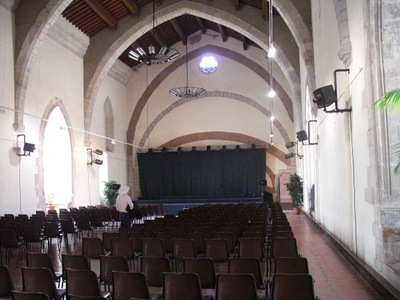
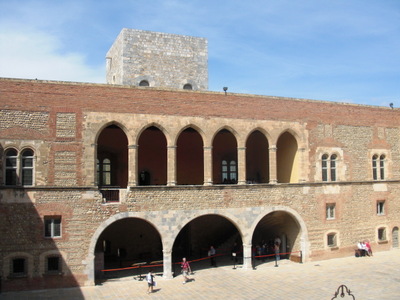 On that same level, along one of the sides of the square was the "aula" (cognate with "hall," I think). As you can see in the photo, it was set up with folding chairs and a stage, for an evening concert I think, but as a room it was just lovely.
On that same level, along one of the sides of the square was the "aula" (cognate with "hall," I think). As you can see in the photo, it was set up with folding chairs and a stage, for an evening concert I think, but as a room it was just lovely.
We continued around the square to this view back across the courtyard to the throne room. The entry to the building is behind the three arches on the lower level, and through the middle arch, you can just make out the stairs going up to the right to the ticket office.
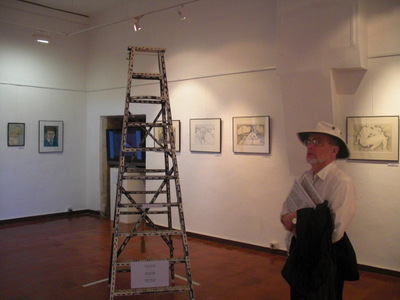
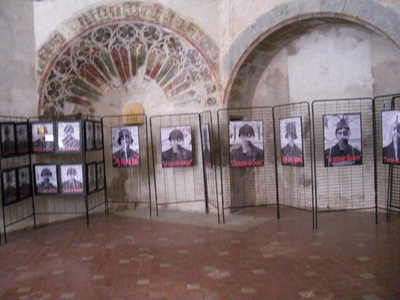 The suites occupied by the the king and queen flanked the upper chapel. Downstairs, at the level of the courtyard, the various rooms were being used to display art, most of it too modern/avant garde/abstract to appeal to us. Here, David studies the one piece that caught my fancy. On one of the rungs is a little label, much smaller than the large "do not climb" sign, that says, "Ceci n'est ni une pipe ni un escabau" (This is neither a pipe nor a stepladder)—a play on a famous painting by Magritte of a pipe whose title is "Ceci n'est pas une pipe" (This is not a pipe).
The suites occupied by the the king and queen flanked the upper chapel. Downstairs, at the level of the courtyard, the various rooms were being used to display art, most of it too modern/avant garde/abstract to appeal to us. Here, David studies the one piece that caught my fancy. On one of the rungs is a little label, much smaller than the large "do not climb" sign, that says, "Ceci n'est ni une pipe ni un escabau" (This is neither a pipe nor a stepladder)—a play on a famous painting by Magritte of a pipe whose title is "Ceci n'est pas une pipe" (This is not a pipe).
In the upper chapel was a much better art exhibition, entitled "Trapped in war." It started with historical photos from World War I, then continued with this long series of framed posters.
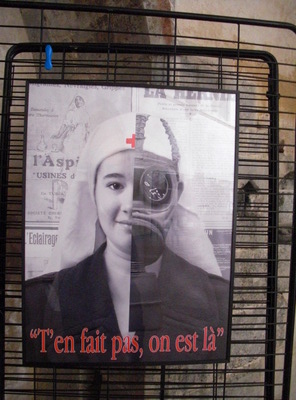
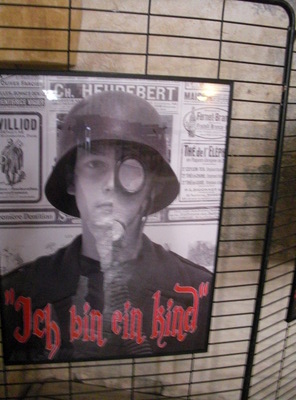 Each poster showed a (modern) photo of a person, dressed in World War I period uniform, against a background of period newspapers, split down the middle between the bare face and the same image wearing a World War I gas mask, and labeled with a short quotation.
Each poster showed a (modern) photo of a person, dressed in World War I period uniform, against a background of period newspapers, split down the middle between the bare face and the same image wearing a World War I gas mask, and labeled with a short quotation.
The one at the left says, "Don't worry, we're here." The one at the right says, in German, "I am a child."
Another of a nurse said, "Soldier, look at who's taking care of you." One of a French soldier said, "I'll skewer (Kaiser) William."
There were dozens, ranging from warlike, to terrified, to references to particular victories or fiascos. David had to explain some of them to me, because he knew the history involved, why some of the soldiers called themselves their general's "dogs," which battles were bungled and which were strategic triumphs. All in all, very effective, I thought.
In the photo above, beyond the throne room is the top of a square tower, the palace's tallest, which formed one link in the chain of signal towers that allowed the alarm to be raised in case of attack at any point along the border (I could see two more from my hotel window, on distant mountain ridges). The military was quite explicit about how much wood and straw had to be stocked in each one, so that the signal could be sent on in response either to sight of the enemy or sight of the signal from an adjoining tower—a large fire on the tower's roof at night, a thick column of smoke (from damp straw) by day. The word could thus be passed in 2 1/2 hours a distance that would have taken 4 1/2 days if carried by riders. Finally, at the bottom of the picture, you can see just the top of the wrought-iron cupola on the courtyard's central well—you can't defend a fort without a good, deep well in the center. We declined the opportunity to climb the tower.
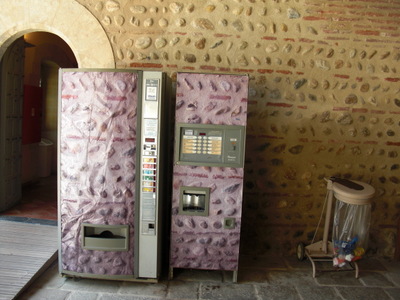
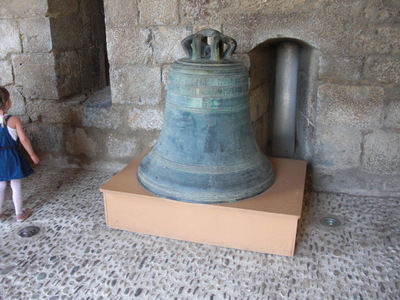 Back down year the entry (also the exit), I spotted these vending machines pretending to be part of the wall behind them. Too bad the photos pasted to their fronts have faded to that pinkish color; when they were fresh, they must have afforded pretty effective camouflage!
Back down year the entry (also the exit), I spotted these vending machines pretending to be part of the wall behind them. Too bad the photos pasted to their fronts have faded to that pinkish color; when they were fresh, they must have afforded pretty effective camouflage!
Near them we saw the two original bells from the chapel's bell tower, now on display in the entrance hall. The tower has bells, and we even heard and saw them ring the hours, by I don't know when they replaced the one shown here.
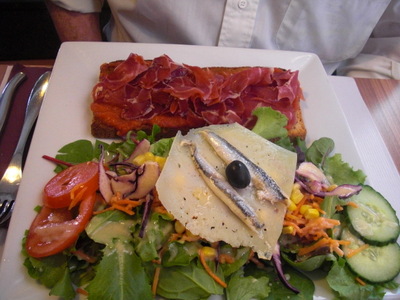
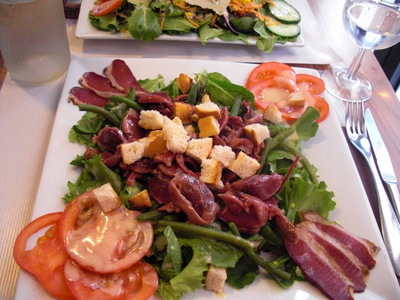 Back outside (down all those stairs and ramps), we decided to cut some of the time off our walk back to the Office de Tourisme by seeking lunch in that direction and found it at Le Petit Moka back in the Place de la République.
Back outside (down all those stairs and ramps), we decided to cut some of the time off our walk back to the Office de Tourisme by seeking lunch in that direction and found it at Le Petit Moka back in the Place de la République.
David had the "assiette Ibérique," salad, a slice of whole-grain bread spread with cooked tomato and topped with slices of Serrano ham, a slice of Manchego cheese topped with two boquerones (anchovies cooked in vinegar) and an olive, and various chopped and shredded veggies.
I had the "assiette Landaise," salad, sliced preserved gizzards (probably duck or turkey), croutons, slices of duck ham, and cooked green beans. ("Assiette" just means "plate.") David's first move was to dump his boquerones and cucumbers onto my plate; I gave him some duck ham in exchange.
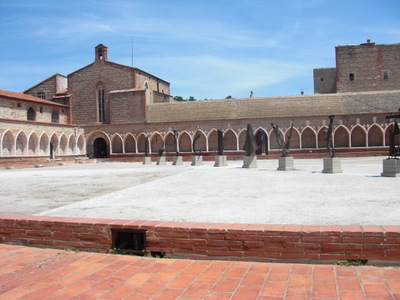
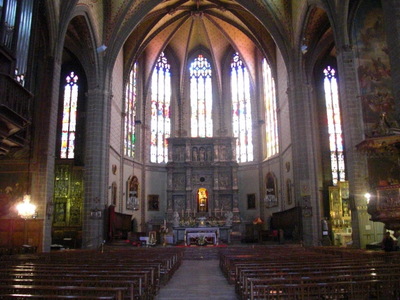 Our walk back to the Office de Tourisme for our afternoon tour took us, first, past an interesting piece of black-and-white graffiti about nine feet tall, portraying a woman balancing on one foot, arms extended and the other leg extended behind, on top of a towering alignment of household brooms, balanced one on top of the other, then past two points of touristic interest: the "campo santo" (holy field) and the cathedral.
Our walk back to the Office de Tourisme for our afternoon tour took us, first, past an interesting piece of black-and-white graffiti about nine feet tall, portraying a woman balancing on one foot, arms extended and the other leg extended behind, on top of a towering alignment of household brooms, balanced one on top of the other, then past two points of touristic interest: the "campo santo" (holy field) and the cathedral.
We just looked in through the arches of the former, a sort of huge cloister the center of which was used as a cemetery but is now occupied by a temporary art exhibition for these large metal pieces, extending in a diagonal line across the open space. The arches are blind now but were once a real cloister, with a walkway behind them. Large signs everywhere emphasize that all and sundry are strictly forbidden to sit in the niches formed by the arches.
We still had plenty of time before the 2:30 p.m. tour, so we spent it in looking around the Cathédrale St. Jean, which was by a large margin the most ornate we had ever seen. Every side chapel was decorated at least as elaborately as the principal apse of most cathedrals, and as you can see, the walls were covered with a great deal of polychrome decoration (as they would have been when the cathedral was originally built).
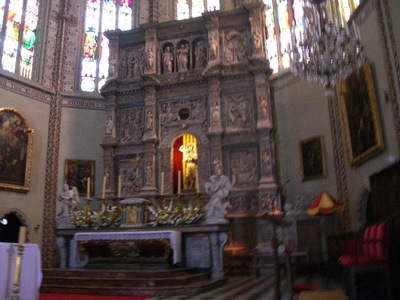
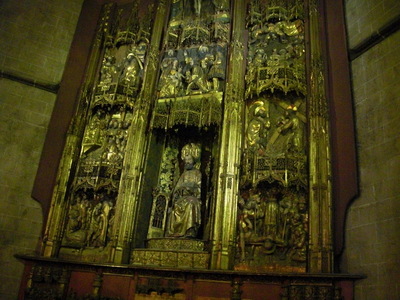 Back at the Office de Tourisme, we rendezvoused with our guide, Alexandra, and about half a dozen other tourists for the 2 1/2 hour tour of the Quartier St. Jean, which includes the Castillet, the cathedral, and the campo santo. The other three historic quarters of the city are St. Matthieu (which includes a whole row of convents along the Basse beyond the Castillet), the "real" (or royal, the hillside below the palace, where the nobility settled to be near the court), and a fourth one whose name I don't remember where the tradesmen and bourgeois settled.
Back at the Office de Tourisme, we rendezvoused with our guide, Alexandra, and about half a dozen other tourists for the 2 1/2 hour tour of the Quartier St. Jean, which includes the Castillet, the cathedral, and the campo santo. The other three historic quarters of the city are St. Matthieu (which includes a whole row of convents along the Basse beyond the Castillet), the "real" (or royal, the hillside below the palace, where the nobility settled to be near the court), and a fourth one whose name I don't remember where the tradesmen and bourgeois settled.
With Alexandra, we started by visiting the vestiges of part of the old town wall, on the edge of the Quartier St. Matthieu. An old photo of it is posted at the spot, and we could see the the tower that formed part of the wall is now buried to about a third of its height.
Then we went to the Campo Santo and went inside this time. It wouldn't be easy to sit in the niches, as the surface on which you'd have to sit was about four feet off the ground.
Next came the Cathedral St. Jean, which we had already toured on our own. The guide pointed out some features we had not noted the first time. For example, in my photo of the nave, above (next to the photo of the campo santo),
at the left edge, you can see part of the large pipe organ. She explained that, when not in use, the organ was originally covered by two large painted panels, hinged so that they could be opened when the organ was played. Those panels are now displayed on the side walls of the chapel opposite the organ.
Also, just out of the frame to the left in that photo, the bottom edge of the organ narrowed to a point and terminated in a wooden moor's head, about twice life size, with an articulated jaw. It doesn't work any more, but when the mechanism was newer, the mouth opened and closed when the organ was played.
The photo at the right above shows a nearer view of the main altar, with its huge, elaborate albaster alterpiece.
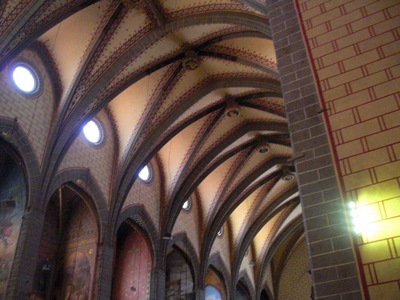
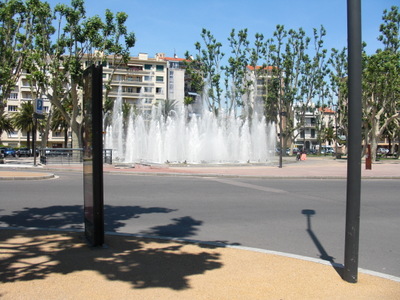 At the left here is the altar of one of the side chapels, with gold altarpiece. All the side chapels were decorated this elaborately, and in addition, the stations of the cross were all reliefs, worked in silver, two or three feet square.
At the left here is the altar of one of the side chapels, with gold altarpiece. All the side chapels were decorated this elaborately, and in addition, the stations of the cross were all reliefs, worked in silver, two or three feet square.
Like other walking tours we've had on this trip, this one consisted less of walking from point of interest to point of interest and more of standing or sitting in front of some point of interest while the guide lectured. Not necessarily a problem, but an interesting difference. I wonder if it represents a trend everywhere or whether it's regional (i.e., that this area has fewer points of interest but more history concentrated at each). Time and more tours will no doubt tell.
From the cathedral, she led us into a narrow alleyway between the cathedral (which is the new one) and the much smaller old cathedral (which you can't go into) to show us a couple of flying buttresses that pass overhead, serving both buildings. A restaurant leases the space in the little alleyway and had its tables set up there for supper. It didn't dawn on me that that very spot was where we'd had a wonderful dinner with French colleagues in 1993, during the Meiofauna meetings. I wish I'd thought of it at the time; I would have asked the restaurant people whether they were they same ones there 21 years ago!
In front of the the Office de Tourisme, where the tour ended, was this fountain. When we arrived, the first time, it was inactive, but by the end of the tour, it was in full play. It looks circular, but in fact, it has a sidewalk right through the middle, between two semicircular halves. You get drenched if you walk that way during the lightest breeze, of course, but it means you can take photos of people who seem to be standing in the middle of the fountain.
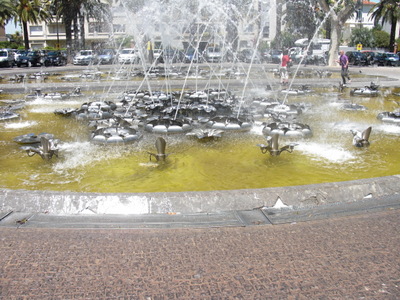
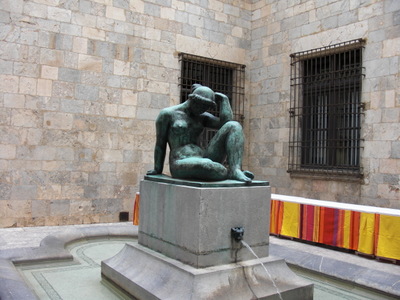 Here's another photo, a few minutes later, when fewer of the jets were active. Each jet is disguised as a large stainless-steel flower.
Here's another photo, a few minutes later, when fewer of the jets were active. Each jet is disguised as a large stainless-steel flower.
Nearby, the guide had pointed out this sculpture, which we had already spotted earlier as unmistakably Maillol. It's one of several around the city. A visit to his studio in nearby Banyuls is on our list of places to go. He's famous for fiddling around with painting, weaving, etc. before settling on sculpture (actually modeling in plaster for later casting in bronze) at about age 40. His work only found favor with the public about the time of his death. He's also famous for taking, as the subject of his work, nothing but the unclad female form, and definitely not a skinny one.
We had dinner at Les Antiquaires, a little mom and pop restaurant near the Place de la République. We both chose the menu at 35 euros (a steal).
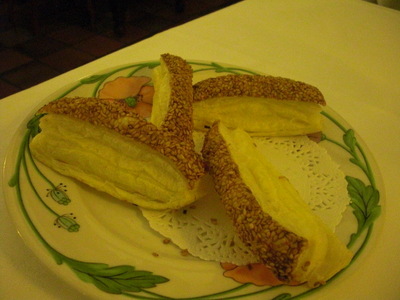
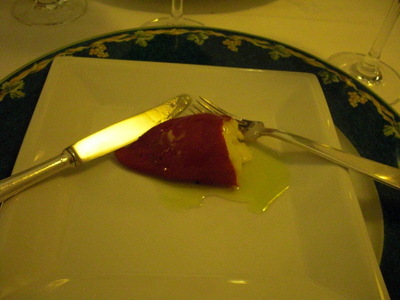 As David points out, the secret to getting an extra amuse-bouche is to have a cocktail or glass of champagne before dinner. Because he always has his "coupe de champagne," we also get the pre-amuse bouche as well as the real one.
As David points out, the secret to getting an extra amuse-bouche is to have a cocktail or glass of champagne before dinner. Because he always has his "coupe de champagne," we also get the pre-amuse bouche as well as the real one.
First amuse-bouche: Batons of puff pastry topped with poppy and sesame seeds. Much more flavorful sesame seeds than most.
Second amuse-bouche: A mild little roasted red pepper stuffed with "brandade de morue," purée of (reconstituted) dried salt cod and mashed potato with garlic. Served cold.
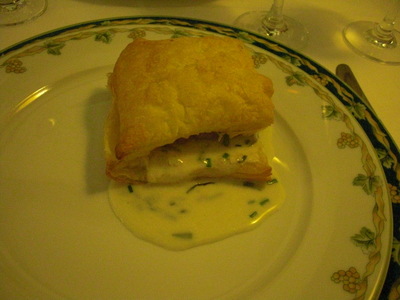
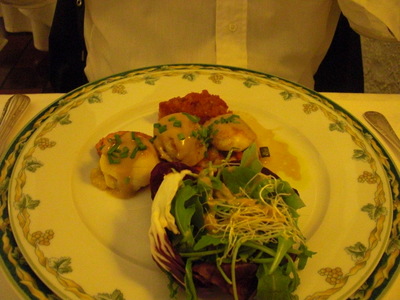 First course, David: Scallops with vinaigrette made with a special Banyuls vinegar. Served with a little salad cupped in a radichio leaf and a spoonful of piperade. I didn't taste it, but it's so far his candidate for best dish of the trip.
First course, David: Scallops with vinaigrette made with a special Banyuls vinegar. Served with a little salad cupped in a radichio leaf and a spoonful of piperade. I didn't taste it, but it's so far his candidate for best dish of the trip.
First course, me: "Feuilleté d'huîtres," a square of crisp puff pastry split and filled with poached oysters in a cream sauce made with Muscat wine. Very good, although they were the most muscular oysters I've ever encountered. Their adductor muscles seemed to occupy a larger-than-usual portion of their area and were chewy, though very tasty.
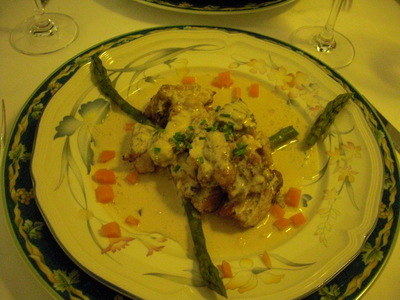
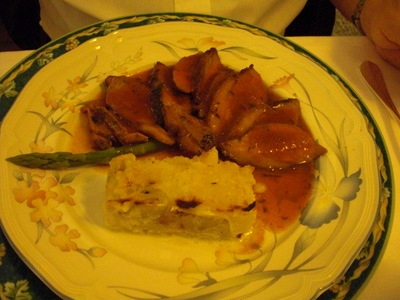 Main course, David: Slices of rare grilled lamb in a sauce of thyme and honey. Square of potato au gratin on the side.
Main course, David: Slices of rare grilled lamb in a sauce of thyme and honey. Square of potato au gratin on the side.
Main course, me: Veal sweetbreads in a morel cream sauce with a scattering of carrots and asparagus spears. They were extremely rich and tender, almost melting into the sauce, but very yummy. As you'll see in meals to come, because of the season, asparagus and morels were a pervasive trend on menus the whole time we were there.
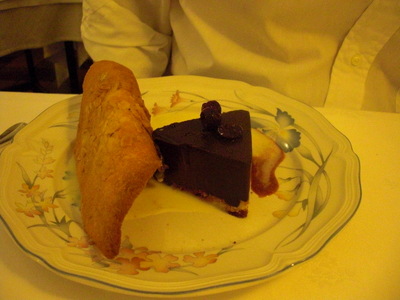
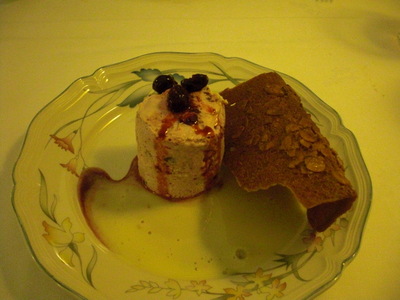 Dessert, David: Ganache au chocolat noire aux cerises confites. A wedge of unbelievably rich and dark chocolate studded and topped with candied dark cherries. Way, way, too chocolate for me. David gave me one bite, which was too much, but he scarfed the rest of it.
Dessert, David: Ganache au chocolat noire aux cerises confites. A wedge of unbelievably rich and dark chocolate studded and topped with candied dark cherries. Way, way, too chocolate for me. David gave me one bite, which was too much, but he scarfed the rest of it.
Dessert, me: Soufflée glac&eacuate;e aux griottes, sour cherry frozen soufflée. It was pretty rich, too, but the tang of the sour cherries help cut through all the cream.
Dinner tomorrow night at La Table.
previous entry
List of Entries
next entry

 At the left is the view from my fifth-floor hotel room and at the right, a better shot (which I got by sticking my camera arm way out the window) of the bizarre red object that dominates the view. When I first looked out, though, it was only the second thing I noticed. What first caught my eye was that incredibly ugly little causeway across the Têt River, between the red object and the apartment building to its right (note the little red "for sale" sign in one of the apartment windows). After studying it a while, I came to the conclusion that it must be temporary. It seems to connect the two sides of a construction site than spans the stream. To facilitate construction traffic back and forth, they laid a whole row of large culvert pipes side by side, then just poured a thick layer of gravel over the top, forcing the river to flow through the pipes to get past. With luck, it will be gone in a few weeks or months.
At the left is the view from my fifth-floor hotel room and at the right, a better shot (which I got by sticking my camera arm way out the window) of the bizarre red object that dominates the view. When I first looked out, though, it was only the second thing I noticed. What first caught my eye was that incredibly ugly little causeway across the Têt River, between the red object and the apartment building to its right (note the little red "for sale" sign in one of the apartment windows). After studying it a while, I came to the conclusion that it must be temporary. It seems to connect the two sides of a construction site than spans the stream. To facilitate construction traffic back and forth, they laid a whole row of large culvert pipes side by side, then just poured a thick layer of gravel over the top, forcing the river to flow through the pipes to get past. With luck, it will be gone in a few weeks or months.
 First order of business was to stop by the Office de Tourisme, and we were pleased to see on the city map the hotel gave us that a branch of it was located quite close by, on the banks of the Basse, Perpignan's other, smaller river, shown here at the left. As you can see, it's a very manicured, well-behaved little river; this stretch is rather bare, but most of it is lined with flowering shrubs in addition to the grass, as well as larger flower beds that appear here. We found no evidence of stairs down, so apparently you're supposed to look but not walk.
First order of business was to stop by the Office de Tourisme, and we were pleased to see on the city map the hotel gave us that a branch of it was located quite close by, on the banks of the Basse, Perpignan's other, smaller river, shown here at the left. As you can see, it's a very manicured, well-behaved little river; this stretch is rather bare, but most of it is lined with flowering shrubs in addition to the grass, as well as larger flower beds that appear here. We found no evidence of stairs down, so apparently you're supposed to look but not walk.
 Next, we passed the Mercure hotel where we stayed in 1993. That was our first encounter with an Accor hotel, and it made a very favorable impression despite its gaudy pink and green decor and the gigantic neon "Mercure" on top—I'm not sure whether I think it's cool or horrifying that that neon monstrosity is still there!
Next, we passed the Mercure hotel where we stayed in 1993. That was our first encounter with an Accor hotel, and it made a very favorable impression despite its gaudy pink and green decor and the gigantic neon "Mercure" on top—I'm not sure whether I think it's cool or horrifying that that neon monstrosity is still there!
 We also passed through a small market in progress in the Place de la République. At the left, an array of fruits and vegetables. At the right, three sizes of live snails for sale. They're all "petits gris" (Helix aspersa, little grays, as opposed to the larger, rounder snails of Burgundy), but they're priced, from smallest to largest, at 8, 10, 12 euros (per hundred, I think).
We also passed through a small market in progress in the Place de la République. At the left, an array of fruits and vegetables. At the right, three sizes of live snails for sale. They're all "petits gris" (Helix aspersa, little grays, as opposed to the larger, rounder snails of Burgundy), but they're priced, from smallest to largest, at 8, 10, 12 euros (per hundred, I think).
 Anyway, when the kings of Majorca took over in 1276, and were in town, they had to stay with the bishop or rich locals, because the city didn't have a suitable palace. Building one took 35 years, and originally, it wasn't fortified; it just sat splendidly on top of its hill south of town. In 1349, the kings of Majorca were defeated by the kings of Aragon, and Aragon and France split up their territories. Later, during the Franco-Spanish wars of the mid 16th century, Perpignan was right on the disputed border, so the palace was enclosed in the massive star-shaped fortress whose entrance appear at the right. (Whenever you look at a map of a French city and see that characteristic star shape, you know what we'll soon be touring.) Later still, when Louis XIV was busy defending and trying to expand his borders, the fortifications were reinforced by (who else?) Vauban. The man was everywhere.
Anyway, when the kings of Majorca took over in 1276, and were in town, they had to stay with the bishop or rich locals, because the city didn't have a suitable palace. Building one took 35 years, and originally, it wasn't fortified; it just sat splendidly on top of its hill south of town. In 1349, the kings of Majorca were defeated by the kings of Aragon, and Aragon and France split up their territories. Later, during the Franco-Spanish wars of the mid 16th century, Perpignan was right on the disputed border, so the palace was enclosed in the massive star-shaped fortress whose entrance appear at the right. (Whenever you look at a map of a French city and see that characteristic star shape, you know what we'll soon be touring.) Later still, when Louis XIV was busy defending and trying to expand his borders, the fortifications were reinforced by (who else?) Vauban. The man was everywhere.
 Inside the entry, we found this long flight of shallow stone steps, flanked by a much more comfortable wooden ramp. At the end of it, we found another, and at that end of that a third. After that, we had only to climb an ordinary flight of metal stairs to the reception desk. We got a discount on admission with the "city passes" that were thrown in when we bought our afternoon tour tickets.
Inside the entry, we found this long flight of shallow stone steps, flanked by a much more comfortable wooden ramp. At the end of it, we found another, and at that end of that a third. After that, we had only to climb an ordinary flight of metal stairs to the reception desk. We got a discount on admission with the "city passes" that were thrown in when we bought our afternoon tour tickets.
 On that same level, along one of the sides of the square was the "aula" (cognate with "hall," I think). As you can see in the photo, it was set up with folding chairs and a stage, for an evening concert I think, but as a room it was just lovely.
On that same level, along one of the sides of the square was the "aula" (cognate with "hall," I think). As you can see in the photo, it was set up with folding chairs and a stage, for an evening concert I think, but as a room it was just lovely.
 The suites occupied by the the king and queen flanked the upper chapel. Downstairs, at the level of the courtyard, the various rooms were being used to display art, most of it too modern/avant garde/abstract to appeal to us. Here, David studies the one piece that caught my fancy. On one of the rungs is a little label, much smaller than the large "do not climb" sign, that says, "Ceci n'est ni une pipe ni un escabau" (This is neither a pipe nor a stepladder)—a play on a famous painting by Magritte of a pipe whose title is "Ceci n'est pas une pipe" (This is not a pipe).
The suites occupied by the the king and queen flanked the upper chapel. Downstairs, at the level of the courtyard, the various rooms were being used to display art, most of it too modern/avant garde/abstract to appeal to us. Here, David studies the one piece that caught my fancy. On one of the rungs is a little label, much smaller than the large "do not climb" sign, that says, "Ceci n'est ni une pipe ni un escabau" (This is neither a pipe nor a stepladder)—a play on a famous painting by Magritte of a pipe whose title is "Ceci n'est pas une pipe" (This is not a pipe).
 Each poster showed a (modern) photo of a person, dressed in World War I period uniform, against a background of period newspapers, split down the middle between the bare face and the same image wearing a World War I gas mask, and labeled with a short quotation.
Each poster showed a (modern) photo of a person, dressed in World War I period uniform, against a background of period newspapers, split down the middle between the bare face and the same image wearing a World War I gas mask, and labeled with a short quotation.
 Back down year the entry (also the exit), I spotted these vending machines pretending to be part of the wall behind them. Too bad the photos pasted to their fronts have faded to that pinkish color; when they were fresh, they must have afforded pretty effective camouflage!
Back down year the entry (also the exit), I spotted these vending machines pretending to be part of the wall behind them. Too bad the photos pasted to their fronts have faded to that pinkish color; when they were fresh, they must have afforded pretty effective camouflage!
 Back outside (down all those stairs and ramps), we decided to cut some of the time off our walk back to the Office de Tourisme by seeking lunch in that direction and found it at Le Petit Moka back in the Place de la République.
Back outside (down all those stairs and ramps), we decided to cut some of the time off our walk back to the Office de Tourisme by seeking lunch in that direction and found it at Le Petit Moka back in the Place de la République. 
 Our walk back to the Office de Tourisme for our afternoon tour took us, first, past an interesting piece of black-and-white graffiti about nine feet tall, portraying a woman balancing on one foot, arms extended and the other leg extended behind, on top of a towering alignment of household brooms, balanced one on top of the other, then past two points of touristic interest: the "campo santo" (holy field) and the cathedral.
Our walk back to the Office de Tourisme for our afternoon tour took us, first, past an interesting piece of black-and-white graffiti about nine feet tall, portraying a woman balancing on one foot, arms extended and the other leg extended behind, on top of a towering alignment of household brooms, balanced one on top of the other, then past two points of touristic interest: the "campo santo" (holy field) and the cathedral.
 Back at the Office de Tourisme, we rendezvoused with our guide, Alexandra, and about half a dozen other tourists for the 2 1/2 hour tour of the Quartier St. Jean, which includes the Castillet, the cathedral, and the campo santo. The other three historic quarters of the city are St. Matthieu (which includes a whole row of convents along the Basse beyond the Castillet), the "real" (or royal, the hillside below the palace, where the nobility settled to be near the court), and a fourth one whose name I don't remember where the tradesmen and bourgeois settled.
Back at the Office de Tourisme, we rendezvoused with our guide, Alexandra, and about half a dozen other tourists for the 2 1/2 hour tour of the Quartier St. Jean, which includes the Castillet, the cathedral, and the campo santo. The other three historic quarters of the city are St. Matthieu (which includes a whole row of convents along the Basse beyond the Castillet), the "real" (or royal, the hillside below the palace, where the nobility settled to be near the court), and a fourth one whose name I don't remember where the tradesmen and bourgeois settled.
 At the left here is the altar of one of the side chapels, with gold altarpiece. All the side chapels were decorated this elaborately, and in addition, the stations of the cross were all reliefs, worked in silver, two or three feet square.
At the left here is the altar of one of the side chapels, with gold altarpiece. All the side chapels were decorated this elaborately, and in addition, the stations of the cross were all reliefs, worked in silver, two or three feet square.
 Here's another photo, a few minutes later, when fewer of the jets were active. Each jet is disguised as a large stainless-steel flower.
Here's another photo, a few minutes later, when fewer of the jets were active. Each jet is disguised as a large stainless-steel flower.
 As David points out, the secret to getting an extra amuse-bouche is to have a cocktail or glass of champagne before dinner. Because he always has his "coupe de champagne," we also get the pre-amuse bouche as well as the real one.
As David points out, the secret to getting an extra amuse-bouche is to have a cocktail or glass of champagne before dinner. Because he always has his "coupe de champagne," we also get the pre-amuse bouche as well as the real one.
 First course, David: Scallops with vinaigrette made with a special Banyuls vinegar. Served with a little salad cupped in a radichio leaf and a spoonful of piperade. I didn't taste it, but it's so far his candidate for best dish of the trip.
First course, David: Scallops with vinaigrette made with a special Banyuls vinegar. Served with a little salad cupped in a radichio leaf and a spoonful of piperade. I didn't taste it, but it's so far his candidate for best dish of the trip.
 Main course, David: Slices of rare grilled lamb in a sauce of thyme and honey. Square of potato au gratin on the side.
Main course, David: Slices of rare grilled lamb in a sauce of thyme and honey. Square of potato au gratin on the side.
 Dessert, David: Ganache au chocolat noire aux cerises confites. A wedge of unbelievably rich and dark chocolate studded and topped with candied dark cherries. Way, way, too chocolate for me. David gave me one bite, which was too much, but he scarfed the rest of it.
Dessert, David: Ganache au chocolat noire aux cerises confites. A wedge of unbelievably rich and dark chocolate studded and topped with candied dark cherries. Way, way, too chocolate for me. David gave me one bite, which was too much, but he scarfed the rest of it.